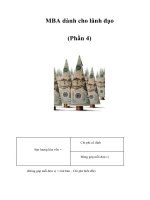Applied C# in Financial Markets phần 4 docx
Bạn đang xem bản rút gọn của tài liệu. Xem và tải ngay bản đầy đủ của tài liệu tại đây (149.38 KB, 13 trang )
20
Applied C# in Financial Markets
before the code body has executed. In Example 2.33 while is used with
an enumerator with the MoveNext method, which will return true until
there are no more records to be processed.
Example 2.33: while loop shown in context of an enumerator
while (fxE.MoveNext())
{
this.lstFX.Items.Add(fxE.Key + "\t " + fxE.Value);
}
2.3.4 do/while
do {code body} while (condition)
do/while is similar to while, the big difference being in evaluating the
condition. In do/while the condition is examined after the code body in
the loop has run, whereas while evaluates the condition before looping.
In Example 2.34 a file is being read until the line returned is null;
note that the ReadLine is executed before the check that line is null.
Example 2.34: do/while loop evaluating the line after the loop being
processed
do
{
line = sIn.ReadLine();
if (line != null)
{
string[] ccFX = rExp.Split(line);
rates.Add(ccFX[0],ccFX[1]);
}
}
while (line != null);
2.3.5 for loop
for (initialise counter; exit condition; counter) {code body}
The block of code in a for loop iterates around with the counter being
initialised, the condition checking and the counter all being on the same
line.
The Basics of C#
21
In Example 2.35 the for loop begins at zero and loops around until
the condition I< initialPool is met; the example shows the for loop
used in initialising a number of database connections.
Example 2.35: For loop showing a number of connections being initialised
private void initConnections()
{
for(int i=0;i< initialPool;i++)
{
addConnection(i);
}
}
2.3.6 foreach loop
foreach (element in collection)
{
code body;
}
The foreach loop is used to iterate through either collections or arrays,
and goes through each element until the last one is reached. In writing a
foreach loop, the structure of the collection should remain unchanged
otherwise the loop could cause some unpredictable results. Example
2.36 shows a collection being created and the elements being iterated
through. The example is taken from a class that builds a dynamic string
of SQL.
Example 2.36: foreach loop being used to iterate through a collection
to build a dynamic SQL query
ICollection keys = hashFields.Keys;
foreach(string key in keys)
{
field.Append(key);
field.Append(",");
}
22
Applied C# in Financial Markets
2.4 SUMMARY
This section has dealt with the basics of programming in C#, covering
operators, data types and how they fit in with control structures.
Operators cover a variety of functionality. At the most simple there
are the assignment operator and the common mathematical operators.
There are also the operators that perform a mathematical operation and
assign the result, and the special prefix and postfix operators used in
incrementing and decrementing values in an integer by one. The logical
operators are widely used in control structures where there are conditional statements, and are often used with conditional operators to join
them together.
Taking all the operators together the order of precedence was looked
at from the point of understanding which operators are ranked higher and
how this impacts the results. In looking at precedence, the importance
of brackets and breaking down complicated calculations as good practice was emphasised, allowing code to be read more easily and making
debugging simpler.
C# is a strongly typed language like C++ and Java. There are a number
of built-in types that are aliased to the classes in the system workspace as
the core of C#. Casting and type converting were examined, as there are
frequently cases where data need moving and objects may return data
as different types. Numeric data have the Parse method to help parse
text data into numeric data; this is widely used where data are captured
in Window forms.
string and StringBuilder are ways of containing string data and
the various methods were examined. It is important when to use string
and StringBuilder as string is immutable while StringBuilder
is mutable.
In looking at string manipulation, the use of regular expressions was
discussed with the Regex class.
Arrays and collections were examined as a useful set of data
types widely used in programs. The distinction between Arrays and
ArrayLists was discussed. With collections the importance of enumerators was examined as a means of iterating through collections and
how to access the data within the iteration loop.
Having looked at the operators and data types, the control structures
were introduced. This showed how the operators and data types are applied in these structures as well as introducing the structures themselves.
Armed with the basics of C#, the more powerful aspects of it are now
examined with application to financial software.
3
Object Oriented Programming
The most powerful aspect of C# is the Object Oriented features and
in this section you will explore these features and how they are applied to a financial application. The Object Oriented concepts are illustrated with code taken from a small futures and options application
sample. The Windows application was written from a practical perspective to demonstrate the various concepts covered from the viewpoint of
a derivatives application. The full source code is available to download
at />Programmers learning C# in finance will perhaps have backgrounds
in C++, Java or Visual Basic. Perhaps the understanding of objects and
classes is a given to most developers, even so a quick overview may be
beneficial before getting into the details of Object Oriented programming
in C# applied to finance.
A class is a description of an object; it describes the properties and
the methods that are encapsulated within it. An object in the programming world is an entity that contains properties and has some defined
behaviour known as methods.
A class becomes an object when it is instantiated; a class cannot be
accessed directly, it must be declared and initialised.
The real power of classes is that the logic is encapsulated and may be
extended, reused. C# has a large range of in-built classes which means
that the developer can begin building the business logic without having
to develop a large toolkit to support Windows applications.
3.1 INTRODUCTION TO CLASSES
[attributes] [modifiers (access)] class identifier
[: list of base classes and/or interfaces]{}
There are a number of basic requirements for creating a class; Example
3.1 shows how a simple class is declared.
Example 3.1: A simple class declaration
using System;
{
24
Applied C# in Financial Markets
public class LogError
{
// . . .
}
}
The first step is to include any references needed in the class; in C#
these are referred to as assemblies. The references are actually DLL, EXE
or project files that are linked to the working project. The keyword using
followed by the reference name is the way to include them; in Example
3.2 the system reference with the basic classes and the references to the
Data, Text, and Odbc classes are included.
Example 3.2: Reference declarations
using System;
using System.Data;
using System.Text;
using Microsoft.Data.Odbc;
In addition to the references, C# has the concept of grouping classes
and interfaces into namespaces. This grouping means that the classes
and public properties are available to one another within the namespace.
Note that if a project is created with no namespace then a default one
gets created anyway.
Looking at how the class is constructed in Example 3.1, the class is
defined with a modifier type, in this case public. The allowable access
modifiers for a class are either public or internal. Public means that
the class is accessible to all assemblies, internal is accessible only to
the files within the assembly to which the class belongs.
Then comes the keyword class followed by the class name (in Example 3.1 this is LogError) and the braces {} are set to denote the scope
of the class.
In creating a class, the next step is to define a constructor, some
methods and properties where applicable. The constructor is how the
object is called when it is being instantiated. Example 3.3 shows how
the LogError class is instantiated and the parameter e passed as the
constructor specifies.
Example 3.3: LogError class instantiated with the parameter being
passed as defined by the constructor
LogError eL = new LogError(e);
Object Oriented Programming
25
In declaring the constructor it must have the same name as the class; if
one is not declared then the default constructor is created by the compiler
with no arguments and no code to execute, as Example 3.4 shows.
Example 3.4: Default constructor
public LogError()
{
}
In Example 3.5 there are two constructors; this is known as constructor
overloading. Overloading is used where there may be a number of different arguments to call the same object; in this case the LogError is
created with either an exception or a string.
Constructor overloading comes into its own when a core class needs
modifying in the way it is called; rather than change every class that
references, a new constructor is written.
Example 3.5: Constructor overloading
public LogError(Exception e)
{
Console.WriteLine(e.StackTrace);
Console.WriteLine(e.Message);
}
public LogError(string err)
{
Console.WriteLine(err);
}
Example 3.6 shows how the LogError object is created with the
different constructors, one having a string passed, the other an exception.
Example 3.6: Having overloaded constructors shows how the
LogError class can be called with different arguments
String eMsg = "Error Message";
LogError eL2 = new LogError(eMsg);
catch (System.DivideByZeroException e)
{
LogError eL = new LogError(e);
}
In addition to the constructor, it is possible to initialise some variables
as the object is created. In Example 3.7 the instance variable r is created
26
Applied C# in Financial Markets
and assigned a value as the object is created. It has been given the
keyword const to indicate that the value may not change; the other
variables have been declared but not initialised and may be modified.
Initialising a variable at the object’s creation is useful for setting default
values, which may be overridden as part of the class behaviour.
Example 3.7: Initialised instance variable r is created and assigned a
value with the object
public class OptionsPrice : Iprice
{
// declare private variables
private const double r = 0.04; // risk free
rate
private double S; // Stock price
private double T; // Days to expiry
private double X; // Strike
private double v; // volatility
private string callPut;
private string symb;
The next stage in creating a class is to give it some behaviour. Setting
the behaviour of a class is done by adding methods. A method is a means
for a class to define some behaviour.
[modifiers (access)] return-type name (parameters) { }
At a minimum, a method must have a return type declared, or be void
if nothing is returned, and a method name. In Example 3.8 a method
getPrice is declared; it takes no parameter arguments, it calls another
method with some instance variables and returns a double. Note if the
return type is not void then the keyword return is required with the correct
return type. The data type can be any valid built-in type or a defined type
within the project; this may be either an object in the project or an object
in a referenced assembly.
Example 3.8: The getPrice method that takes no parameter arguments and returns a double
public double getPrice()
{
price = BlackScholes( callPut, S, X, T, r, v);
return price;
}
Object Oriented Programming
27
Table 3.1 Access modifiers in methods
Access type
Description
public
private
protected
internal
visible by all classes
only available within the class
accessible to the class and to classes derived from the class
accessible to the current project
Example 3.8 was declared with the access type as public. Table 3.1
shows the other access types and what they mean.
Example 3.9 shows an example of a method that is declared with a
number of parameters; this is then called as shown in Example 3.8.
Example 3.9: A method with a list of parameters declared
private double BlackScholes(string CallPutFlag, double
S,double X,double T, double r, double v)
Parameters are passed by value by default; to pass by reference the
keywords ref or out are used. The difference in passing by value and
by reference is that when a variable is passed as a parameter by value a
copy is being passed and it can be changed within the object without the
variable in the calling method being changed. The ref keyword means
that the parameter is passed by reference so that any changes that occur to
the parameter within the program will be reflected in the calling method
and the variable. The out keyword is very similar to ref only in that
the variable must be declared and initialised when used in conjunction
with ref, whereas out does not need the variable initialised.
There are some performance improvements if large objects are passed
by reference, thus avoiding creating a copy of the large object. However,
it may be clearer in the code to have getter and setter methods or
properties to return the data rather than ‘by reference’ updating.
Example 3.10: A class with two methods that pass by value and reference respectively
public class ValueAndReference
{
public ValueAndReference()
{
}
public float getInterestByVal(float coupon,
float days,float months)
28
Applied C# in Financial Markets
{
float result = coupon * months / days;
days = 365;
months = 15;
return result;
}
public float getInterestByRef(ref float
coupon,ref float days,ref float months)
{
float result = coupon * months / days;
days = 365;
months = 15;
return result;
}
}
private void doSomething()
{
float coupon = 0.033F;
float days = 360F;
float months = 30F;
ValueAndReference T = new ValueAndReference();
float intVal = T.getInterestByVal(coupon,days,months);
Console.WriteLine("Coupon = " + coupon + " Days = "
+ days + " months = " + months);
float intRef = T.getInterestByRef(ref coupon,ref
days,ref months);
Console.WriteLine("Coupon = " + coupon + " Days = "
+ days + " months = " + months);
}
Output:
Coupon = 0.033 Days = 360 months = 30
Coupon = 0.033 Days = 365 months = 15
The other important feature of a class is being able to define properties; this encapsulates the class data. Properties are ways of setting and
Object Oriented Programming
29
retrieving data, and they may be defined independently to set and return
data.
Example 3.11 shows the property name with a getter and setter
type being declared.
Example 3.11: Property symbol with get and set declared
public string symbol
{
get{ return (string) derivAttrib["symbol"]; }
set{ derivAttrib["symbol"] = value;}
}
Accessing the property is shown in Example 3.12; it is assigned to or
returned from like an instance variable.
Example 3.12: Working with the symbol property
Option o = new Option();
o.symbol = symb;
Console.Write("Symbol set to : " + o.symbol);
This is a shortened way of creating a get and set method to set
and retrieve data. Example 3.12 shows a simplistic property; the set
method would usually have some data validation steps to ensure data
integrity.
The alternative to properties is to write a get and set method; this
would be accessed as a regular method when called.
The basics of writing a class have now been covered. Later in this
chapter, we will explore how classes fit together with inheritance and
polymorphism and how it is applied to finance.
3.1.1 Exception handling
try
{
}
catch(Exception e)
{
}
finally
{
}
30
Applied C# in Financial Markets
In all applications the ability to handle exceptions is fundamental, as
there are circumstances in a program when the ‘unexpected’ happens.
In C# there are a wide variety of built-in system exceptions; in addition,
exception classes can be written to handle specific errors.
An exception is handled in a try/catch block. The try block around
a block of code denotes the code where the exception is being handled.
The catch keyword is used with the braces {} to handle the exception.
The catch statement may be used to handle as many exceptions as are
required, for example there may be a need to handle divide by zero
exceptions, and in the case of numeric overflow two catch statements
are required.
In addition to catch there is the finally keyword, the purpose of
which is to execute the block of code regardless of whether there has
been an exception or not. The finally block is useful, for example, in
closing open database connections or files.
In Example 3.13 the try/catch blocks handle database errors; note
in this example that the finally statement is always called to release
the connection back to the pool.
Example 3.13: try block around a database and a catch block to
handle errors
public DataSet dbSelect(string sqlstr)
{
ConnectPool c = ConnectPool.GetInstance();
OdbcConnection con = c.getConnection();
DataSet DSet = new DataSet();
try
{
dbAdapter.SelectCommand = con.CreateCommand();
dbAdapter.SelectCommand.CommandText = sqlstr;
dbAdapter.Fill(DSet);
}
catch (OdbcException dbE)
{
LogError eLog = new LogError(dbE);
eLog.writeErr(sqlstr);
DSet = null;
}
finally
{
c.releaseConnection();
Object Oriented Programming
31
}
return DSet;
}
3.1.2 User defined exception class
In addition to the wealth of exception classes there are times when a
customised error needs to be generated and caught to deal with a specific
set of conditions.
In the futures and options application there is a trade booking section;
before a trade is booked there is a check to ensure that the mandatory
fields are completed. If any of the mandatory field values are missing
then an exception needs throwing to alert the user that there are missing
fields. In generating the exception the keyword throw is used.
Note the user defined exception classes derive from the
ApplicationException and NOT the SystemException class. The
three constructors shown in Example 3.14 must be present in userdefined exceptions.
In Example 3.14 the exception is a very simple implementation of
a user defined exception class using the functionality of the base class
ApplicationException.
Example 3.14: User defined exception class, TradeException
public class TradeException : System.Application
Exception
{
// Default constructor
public TradeException() : base("Trade Exception
Thrown")
{
}
// Custom constructor that receives a string
public TradeException(string msg) : base(msg)
{
}
// Constructor that receives string and Exception
public TradeException(string message,Exception exp)
: base(message,exp)
{
}
}
32
Applied C# in Financial Markets
Example 3.15 shows how the TradeException is thrown if one of
the checks are not met.
Example 3.15: Throwing a TradeException
private void performValidations()
{
Boolean err = false;
StringBuilder msg = new StringBuilder();
msg.Append("Validation error has occurred:");
// Check trading Account
if ( tacct.Length == 0)
{
msg.Append("Blank Trading account - mandatory
field \n");
err = true;
}
// Check customer account
if( custacct.Length == 0)
{
msg.Append("Blank Customer account - mandatory
field \n");
err = true;
}
// Check quantity
if ( qty < 0)
{
msg.Append("Cannot have a negative quantity, use
buy or sell to correct \n");
err = true;
}
if( bs.Length == 0)
{
msg.Append("Must have either a buy or sell\n");
err = true;
}
if( symbol.Length == 0)
{
msg.Append("Symbol is required - mandatory
field \n");
err = true;
}









